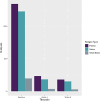Establishment of a Lassa Fever Specimen Biobank in Nigeria
- PMID: 40425001
- PMCID: PMC12360083
- DOI: 10.4269/ajtmh.24-0527
Establishment of a Lassa Fever Specimen Biobank in Nigeria
Abstract
Despite being a dangerous disease found across West Africa, with occasional cases imported elsewhere, few medical countermeasures for Lassa fever are available, with no vaccine or validated treatment, and limited regulatory-approved diagnostics. Scientific research on the Lassa virus (LASV) is needed to accelerate the development of such tools but is dependent on access to high-quality biological samples. To meet this need, we have established a well-curated biobank to prospectively collect, process, and store high-quality, well-characterized clinical specimens from patients with Lassa fever at the Federal Medical Center Owo (FMCO) in Nigeria. Patients presenting to FMCO with symptoms of Lassa fever were tested for LASV by polymerase chain reaction and screened for eligibility. Samples of whole blood, plasma, and serum were collected at baseline, and at 4- and 8-weeks post-baseline from LASV-positive (LASV+) participants. Of 197 participants enrolled, 99 were LASV+ and 98 LASV-negative. In total, 3,599 sample aliquots were stored, comprised of 264 whole blood, 1,572 serum, and 1,763 plasma samples. The Lassa fever biobank now provides support for scientific research, including the evaluation of diagnostics and biomarkers, as well as the development and validation of other medical countermeasures for the detection, prevention, and control of Lassa fever. Processes for accessing samples are described.
Conflict of interest statement
Disclosures: H. F. Chi, F. Fongkeng, D. G. Bausch, I. El Idrissi, W. Fransman, C. Kelly-Cirino, E. Agogo, and D. M. Emperador declare that they were employed by FIND at the time of the study. The funders of this study had no role in study design, data collection and analysis, decision to publish, or preparation of the manuscript.
Figures
References
-
- WHO, 2017. Lassa Fever. Available at: https://www.who.int/news-room/fact-sheets/detail/lassa-fever. Accessed May 28, 2024.
-
- WHO, 2019. Lassa Fever Research and Development (R&D) Roadmap. Available at: https://www.who.int/publications/m/item/lassa-fever-research-and-develop.... Accessed May 28, 2024.
-
- WHO, 2023. Lassa Fever—Nigeria. Available at: https://www.who.int/emergencies/disease-outbreak-news/item/2023-DON463#. Accessed May 28, 2024.
MeSH terms
LinkOut - more resources
Full Text Sources




